Cross-Layer and SDN Based Routing Scheme for P2P Communication in Vehicular Ad-Hoc Networks
Abstract
Featured Application
Abstract
1. Introduction
2. Methods
2.1. SDVN Framework
2.1.1. Registering Phase
2.1.2. Route Prediction Phase
2.1.3. Access Wireless Communication Protocol
2.2. Proposed Routing Scheme
2.2.1. Routing Metrics
- A.
- Forwarding probability
- B.
- Link duration
- C.
- Wireless bandwidth allocation
2.2.2. Routing Format
2.2.3. Routing Table
2.2.4. Route Establishment and Data Transmission
- (i)
- each vehicle sends “state updating” messages (line 2),
- (ii)
- the source vehicle sends RREQ packet (line 3),
- (iii)
- the local controllers distribute RREP packets for link establishment (lines 4–10),
- (iv)
- route refreshing phase (lines 11–14).
| Algorithm 1 route discovery process. |
| Input: NodeSet |
| Output: Routing path from source vehicle to destination |
| Initialize: CycleSet, PathSet, Head, Tail |
| Notation: |
| NodeSet: The vehicle’s location at current cycle |
| CycleSet: The prediction of vehicle’s location at next cycle |
| PathSet: The stack used to store routing path |
| 1. Begin |
| 2. if NodeSet is empty |
| 3. say ‘error’ and go to 25 |
| 4. end if |
| 5. if Distance (Source_node, Destination_ node) |
| >Distance_Threshold |
| 6. say ‘error’ and go to 25 |
| 7. CycleSet = calculate NodeSet location after |
| Cycle |
| 8. Head = Source_node |
| 9. Tail = Destination_node |
| 10. Push (PathSet, Head) |
| 11. Sort CycleSet by Distance (CycleSet, Head) |
| 12. for each Nodei CycleSet from Head to Tail |
| 13. if Distance (Head, ) < |
| Communication Radius of Vehicle AND |
| > threshold value |
| 14. if > threshold |
| AND interval time |
| 15. Push (PathSet, Nodei) AND |
| Head = Nodei |
| 16. end if |
| 17. end if |
| 18. end for |
| 19. check if PathSet.top! = Tail AND |
| PathSet.top! = Null |
| 20. Nodex = pop(PathSet) AND delete Nodex |
| from CycleSet AND Head = PathSet.top |
| AND go to 12 |
| 21. end if |
| 22. if PathSet.top = Null |
| say’ error’ and go to 25 |
| 23. end if |
| 24. say ‘success’ |
| 25. END Algorithm 1 |
| Algorithm 2 the whole session process. |
| Input: Source vehicle |
| Output: Forward the data packet toward destination vehicle |
| Notation: |
| PathSet: The data structure used to store routing path |
| CSI: The channel state information |
| Next_Hop: The next hop vehicle |
| 1. Begin |
| 2. Each vehicle periodically unicasts message |
| “Hello_msg” to nearest RSU with fields: velocity, location, pseudo-ID, CSI |
| 3. The source vehicle generates data to send |
| AND sends RREQ message to nearest RSU |
| 4. The local controllers cooperate with SDN |
| controllers establish Pathset by Algorithm 1 |
| OR repair the damaged path |
| 5. The controller group sets an interval |
| Time |
| 6. for each controller |
| unicasts RREPi message to Nodei within its coverage AND Nodei Pathset with fields: Rsu_ID, Vehicle_ID, Package_ID, Last_Hop, Next_Hop, SendTime, DelayTime, ExpiredTime, CMC |
| 7. end for |
| 8. for each Nodei Pathset |
| 9. when Nodei receives RREPi then |
| immediately updates the Routing table AND connects with Next_Hop marked in RREPi |
| 10. end for |
| 11. if link establishment fails OR link damages |
| 12. go to 4 |
| 13. else |
| 14. link maintains Until time out then go |
| to 4 OR data transmission finishes then go to 15 |
| 15. end if |
| 16. END Algorithm 2 |
3. Results and Discussion
3.1. Performance Analysis
3.1.1. Benefits of SDN Migration
3.1.2. Cross-Layer Solution
3.1.3. Communication Load
3.2. Simulation Evaluation
4. Conclusions
Author Contributions
Funding
Conflicts of Interest
References
- Kaur, M. Vehicular Ad Hoc networks. J. Glob. Res. Comput. Sci. 2012, 3, 61–64. [Google Scholar]
- Kaiwartya, O.; Abdullah, A.H.; Cao, Y.; Altameem, A.; Prasad, M.; Lin, C.-T.; Liu, X.; Lin, C.-T. Internet of Vehicles: Motivation, Layered Architecture, Network Model, Challenges, and Future Aspects. IEEE Access 2016, 4, 5356–5373. [Google Scholar] [CrossRef]
- Bhat, S.; Udechukwu, R.; Dutta, R.; Rouskas, G.N. Network service orchestration in heterogeneous 5G networks using an open marketplace. IET Netw. 2017, 6, 149–156. [Google Scholar] [CrossRef]
- Omheni, N.; Bouabidi, I.; Gharsallah, A.; Zarai, F.; Obaidat, M.S.; Imen, B. Smart mobility management in 5G heterogeneous networks. IET Netw. 2018, 7, 119–128. [Google Scholar] [CrossRef]
- Daraghmi, Y.-A.; Yi, C.-W.; Stojmenovic, I. Forwarding methods in data dissemination and routing protocols for vehicular Ad Hoc networks. IEEE Netw. 2013, 27, 74–79. [Google Scholar] [CrossRef]
- Wu, C.; Ohzahata, S.; Ji, Y.; Kato, T. How to utilize inter-flow network coding in VANETs: A backbone based approach. IEEE Trans. Intell. Transp. Syst. 2016, 17, 2223–2237. [Google Scholar] [CrossRef]
- Venkatramana, D.K.N.; Srikantaiah, S.B.; Moodabidri, J. SCGRP: SDN-enabled connectivity-aware geographical routing protocol of VANETs for urban environment. IET Netw. 2017, 6, 102–111. [Google Scholar] [CrossRef]
- Khushdeep, S.; Sanjay, B.; Alka, J.; Amardeep, S. Trusted border-node based most forward within radius routing protocol. Int. J. Adv. Res. Comput. Sci. 2014, 5, 216–230. [Google Scholar]
- Nunes, B.A.A.; Mendonca, M.; Nguyen, X.-N.; Obraczka, K.; Turletti, T.; Nunes, B.A.A. A Survey of Software-Defined Networking: Past, Present, and Future of Programmable Networks. IEEE Commun. Surv. Tutor. 2014, 16, 1617–1634. [Google Scholar] [CrossRef]
- Fontes, R.D.R.; Campolo, C.; Rothenberg, C.E.; Molinaro, A. From Theory to Experimental Evaluation: Resource Management in Software-Defined Vehicular Networks. IEEE Access 2017, 5, 3069–3076. [Google Scholar] [CrossRef]
- Zhang, J.; Wang, X.; Wang, C.; Zhou, M.; Jiang, C. Improved Rule Installation for Real-Time Query Service in Software-Defined Internet of Vehicles. IEEE Trans. Intell. Transp. Syst. 2016, 18, 225–235. [Google Scholar]
- Li, H.; Dong, M.; Ota, K. Control Plane Optimization in Software-Defined Vehicular Ad Hoc Networks. IEEE Trans. Veh. Technol. 2016, 65, 7895–7904. [Google Scholar] [CrossRef]
- Alioua, A.; Senouci, S.-M.; Moussaoui, S.; Eichler, G.; Erfurth, C.; Fahrnberger, G. dSDiVN: A Distributed Software-Defined Networking Architecture for Infrastructure-Less Vehicular Networks. Relat. Datenbanken 2017, 717, 56–67. [Google Scholar]
- Ku, I.; Lu, Y.; Gerla, M.; Gomes, R.L.; Ongaro, F.; Cerqueira, E. Towards software-defined VANET: Architecture and services and services. In Proceedings of the Ad Hoc Networking Workshop, MED-HOC-NET 2014, Piran, Slovenia, 2–4 June 2014; pp. 103–110. [Google Scholar]
- Liu, Y.-C.; Chen, C.; Chakraborty, S. A software defined network architecture for GeoBroadcast in VANETs. In Proceedings of the IEEE International Conference on Communications (ICC), London, UK, 8–12 June 2015; pp. 6559–6564. [Google Scholar]
- Dong, B.; Wu, W.; Yang, Z.; Li, J. Software defined networking based on-demand routing protocol in vehicle ad hoc networks. In Proceedings of the 12th International Conference on Mobile Ad-Hoc and Sensor Networks (MSN), Hefei, China, 16–18 December 2016; pp. 207–213. [Google Scholar]
- Wan, J.; Zhang, D.; Sun, Y.; Lin, K.; Zou, C.; Cai, H. VCMIA: A novel architecture for integrating vehicular cyber-physical systems and mobile cloud computing. Mob. Netw. Appl. 2014, 19, 153–160. [Google Scholar] [CrossRef]
- Aujla, G.S.; Chaudhary, R.; Kumar, N.; Rodrigues, J.J.P.C.; Vinel, A. Data Offloading in 5G-Enabled Software-Defined Vehicular Networks: A Stackelberg-Game-Based Approach. IEEE Commun. Mag. 2017, 55, 100–108. [Google Scholar] [CrossRef]
- Yang, F.; Wang, S.; Li, J.; Liu, Z.; Sun, Q. An overview of internet of vehicles. China Commun. 2014, 11, 1–15. [Google Scholar] [CrossRef]
- Dong, B.; Wu, W.; Yang, Z.; Li, J. Software Defined Networking Based On-Demand Routing Protocol in Vehicle Ad-Hoc Networks. ZTE Commun. 2017, 2, 1673–5188. [Google Scholar]
- Zhang, D.; Yu, F.R.; Wei, Z.; Boukerche, A. Trust-based Secure Routing in Software-Defined Vehicular Ad Hoc Networks. arXiv 2016, arXiv:1611.04012. [Google Scholar]
- Thota, J.; Almesaeed, R.; Doufexi, A.; Armour, S.; Nix, A.R. Infrastructure to Vehicle Throughput Performance in LTE-A Using 2D and 3D 3GPP/ITU Channel Models. In Proceedings of the IEEE 81st Vehicular Technology Conference (VTC Spring), Glasgow, UK, 11–14 May 2015; pp. 1–5. [Google Scholar]
- Liu, J.; Kato, N.; Ma, J.; Kadowaki, N. Device-to-device communication in LTE-advanced networks: A survey. IEEE Commun. Surv. Tutor. 2015, 17, 1923–1940. [Google Scholar] [CrossRef]
- Shaik, S.; Ratnam, D.V.; Bhandari, B.N. An Efficient Cross Layer Routing Protocol for Safety Message Dissemination in VANETS with Reduced Routing Cost and Delay Using IEEE 802.11p. Wirel. Pers. Commun. 2018, 100, 1765–1774. [Google Scholar] [CrossRef]
- Yu, Y.T.; Gerla, M.; Sanadidi, M.Y. Scalable VANET content routing using hierarchical bloom filters. Wirel. Commun. Mob. Comput. 2015, 15, 1629–1634. [Google Scholar] [CrossRef]
- Rawat, D.B.; Bista, B.B.; Yan, G. CoR-VANETs: Game Theoretic Approach for Channel and Rate Selection in Cognitive Radio VANETs. Traffic Eng. 2010, 23, 56–62. [Google Scholar]
- Hassan, M.U.; Karim, S.; Shah, S.K.; Abbas, S.; Yasin, M.; Shahzaib, M.; Umair, M. A Comparative Study on Frequent Link Disconnection problems in VANETs. EAI Endorsed Trans. Energy Web 2018, 5, e2. [Google Scholar]
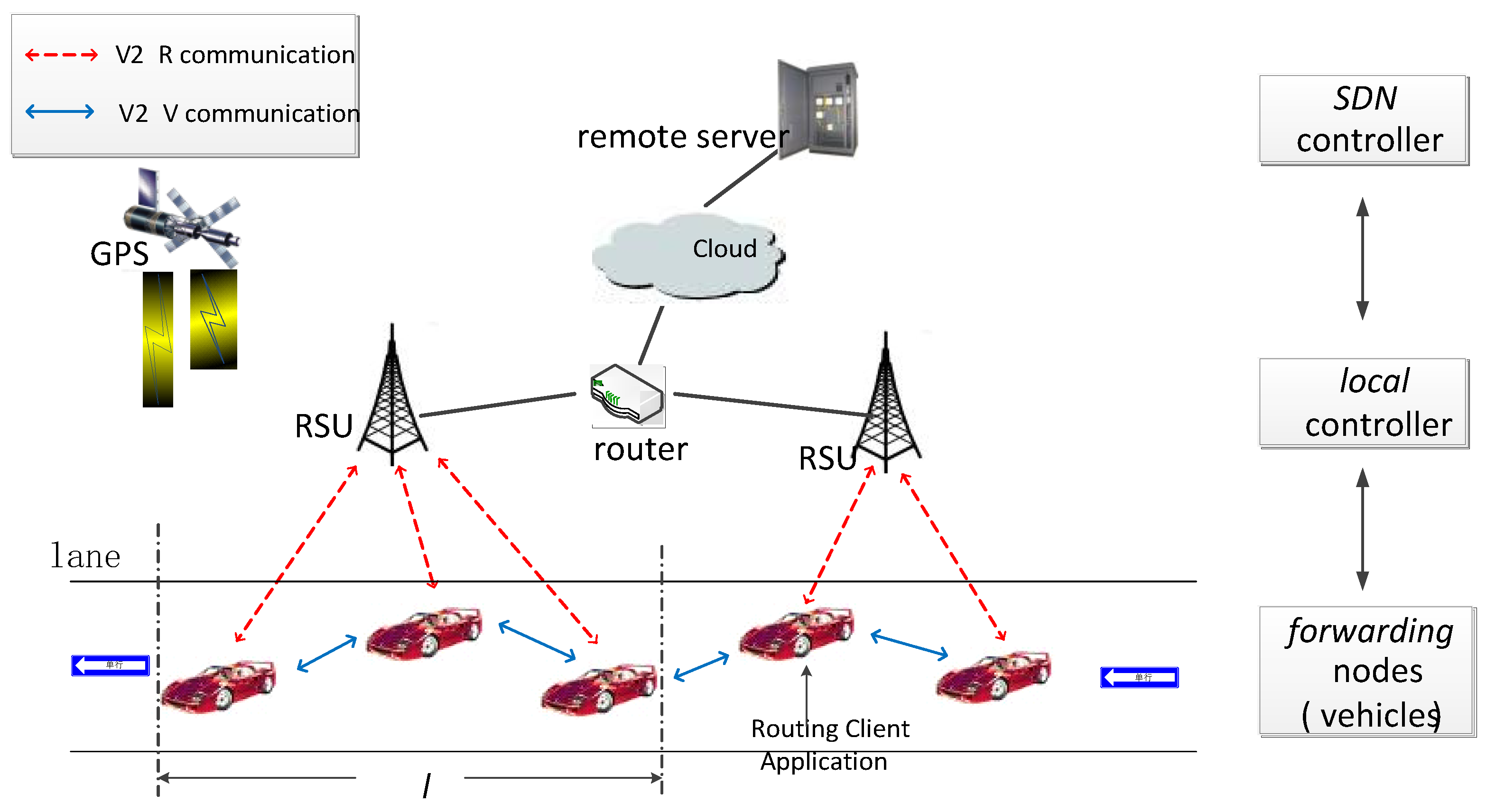

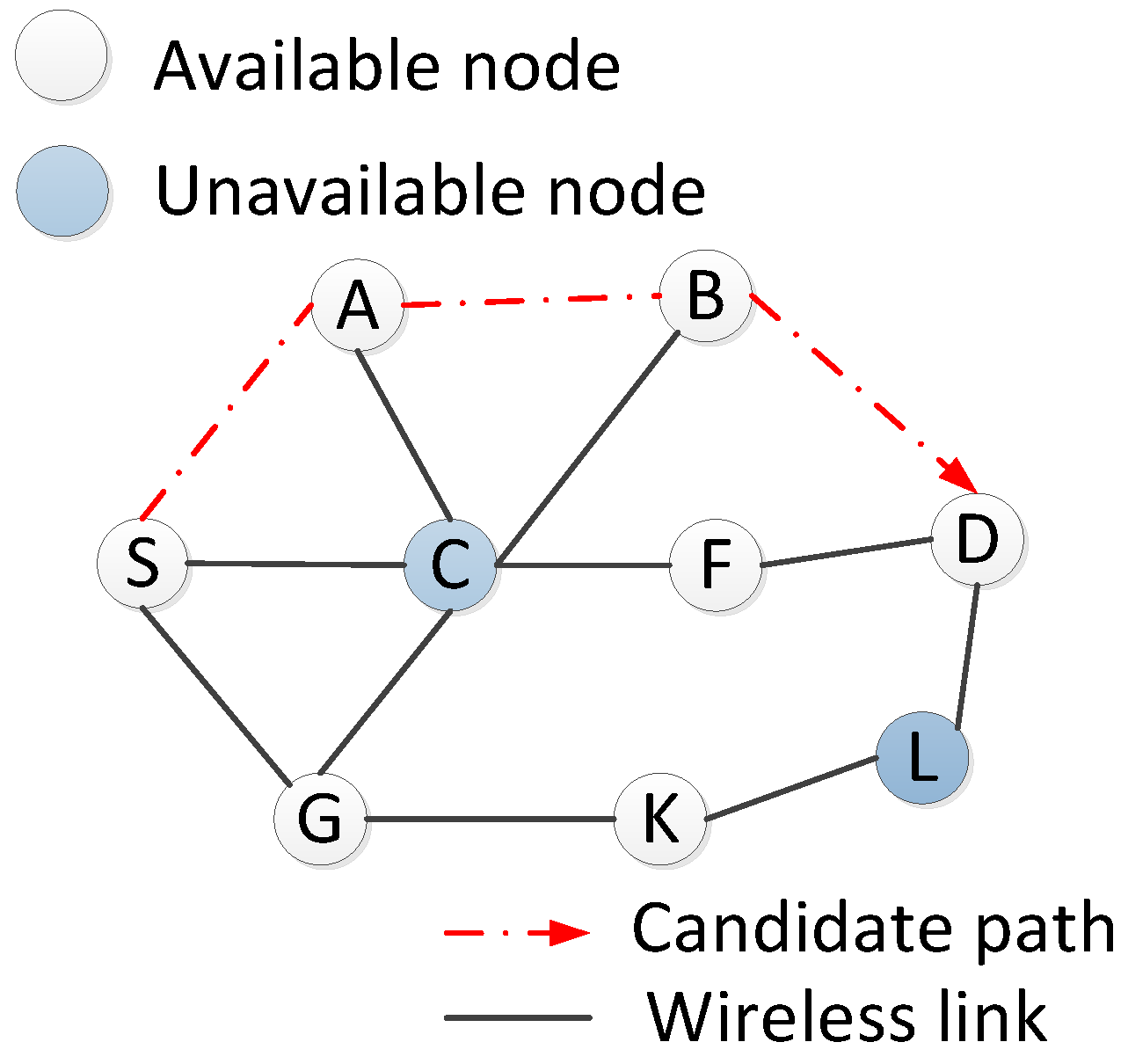
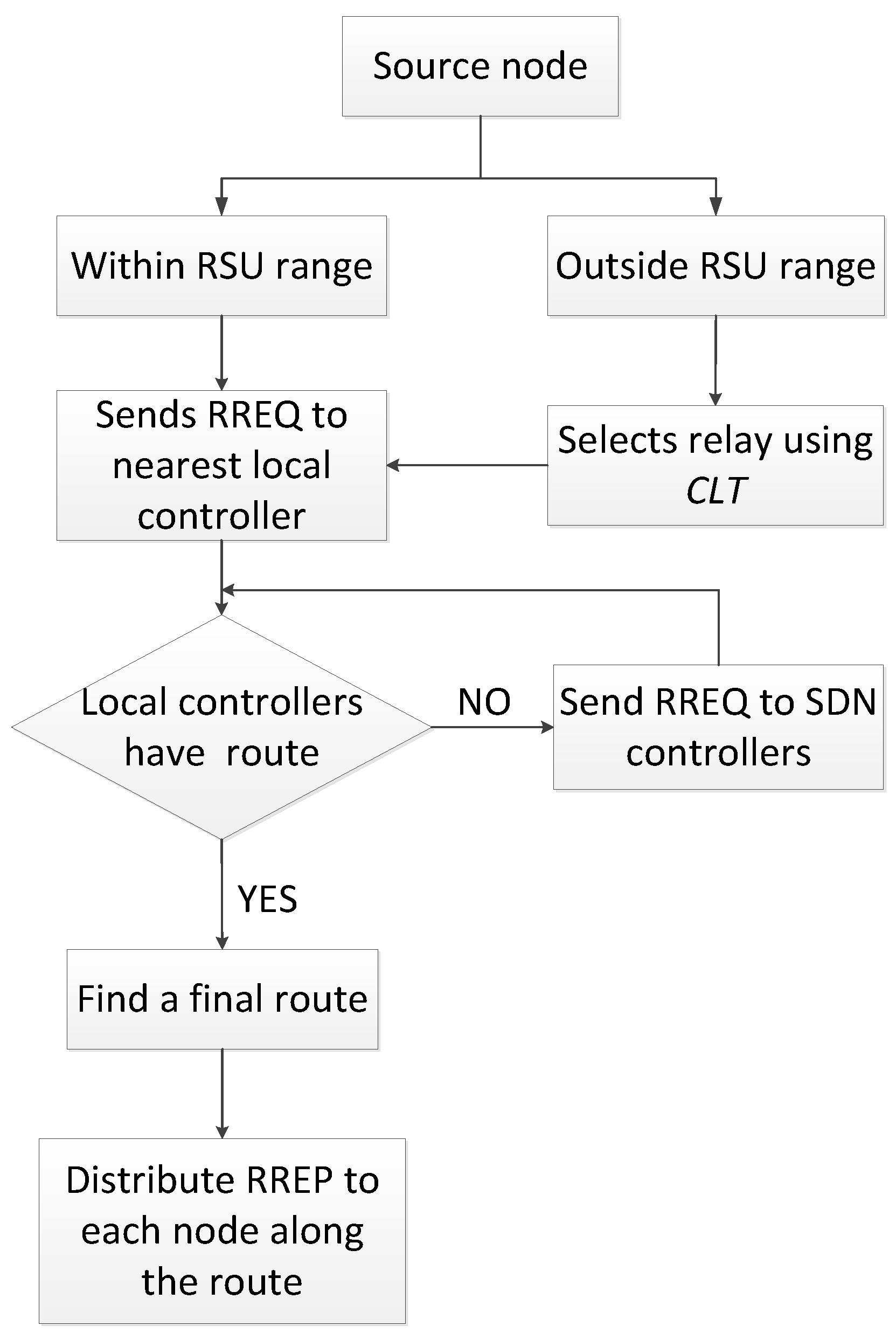
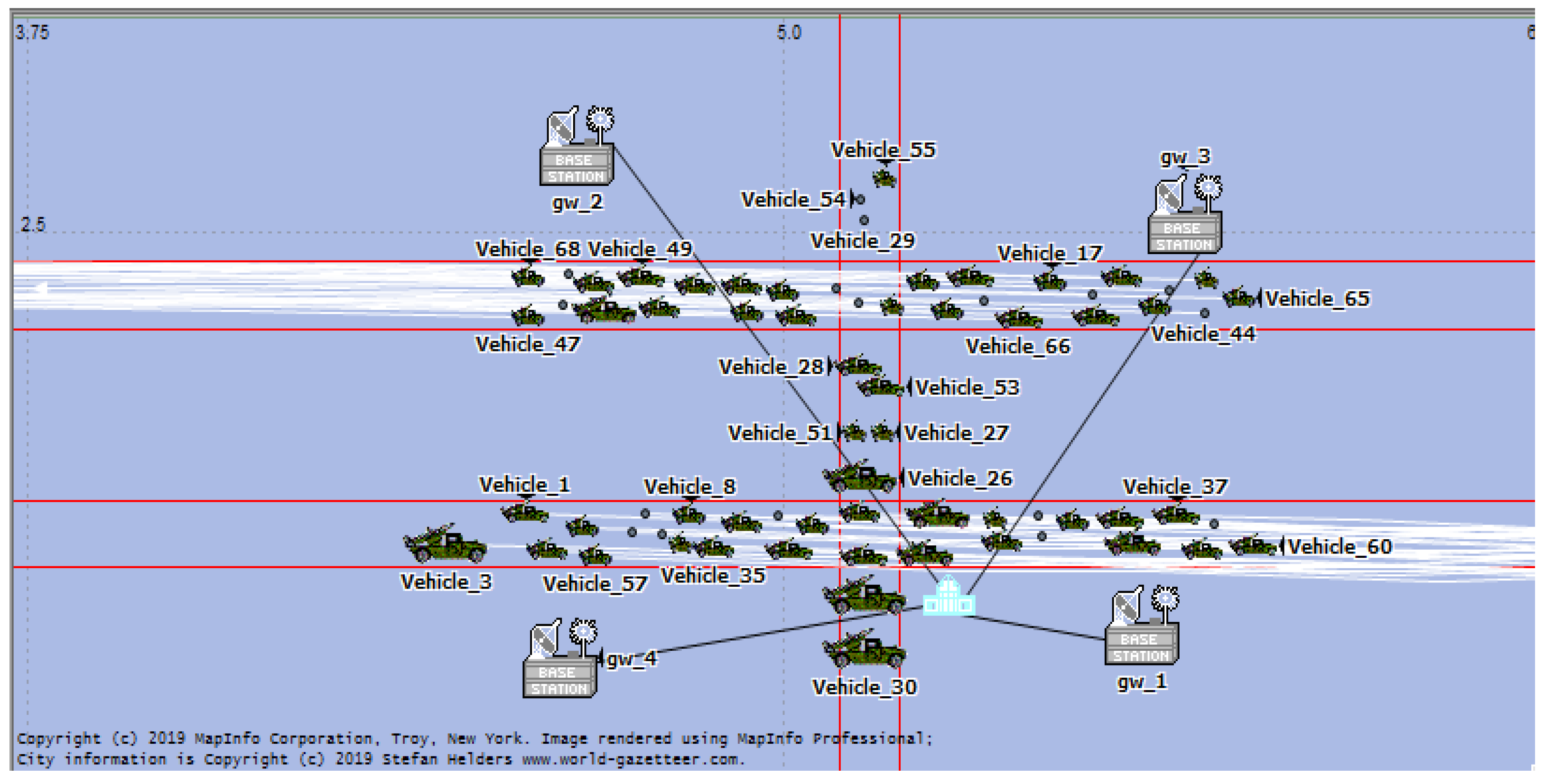
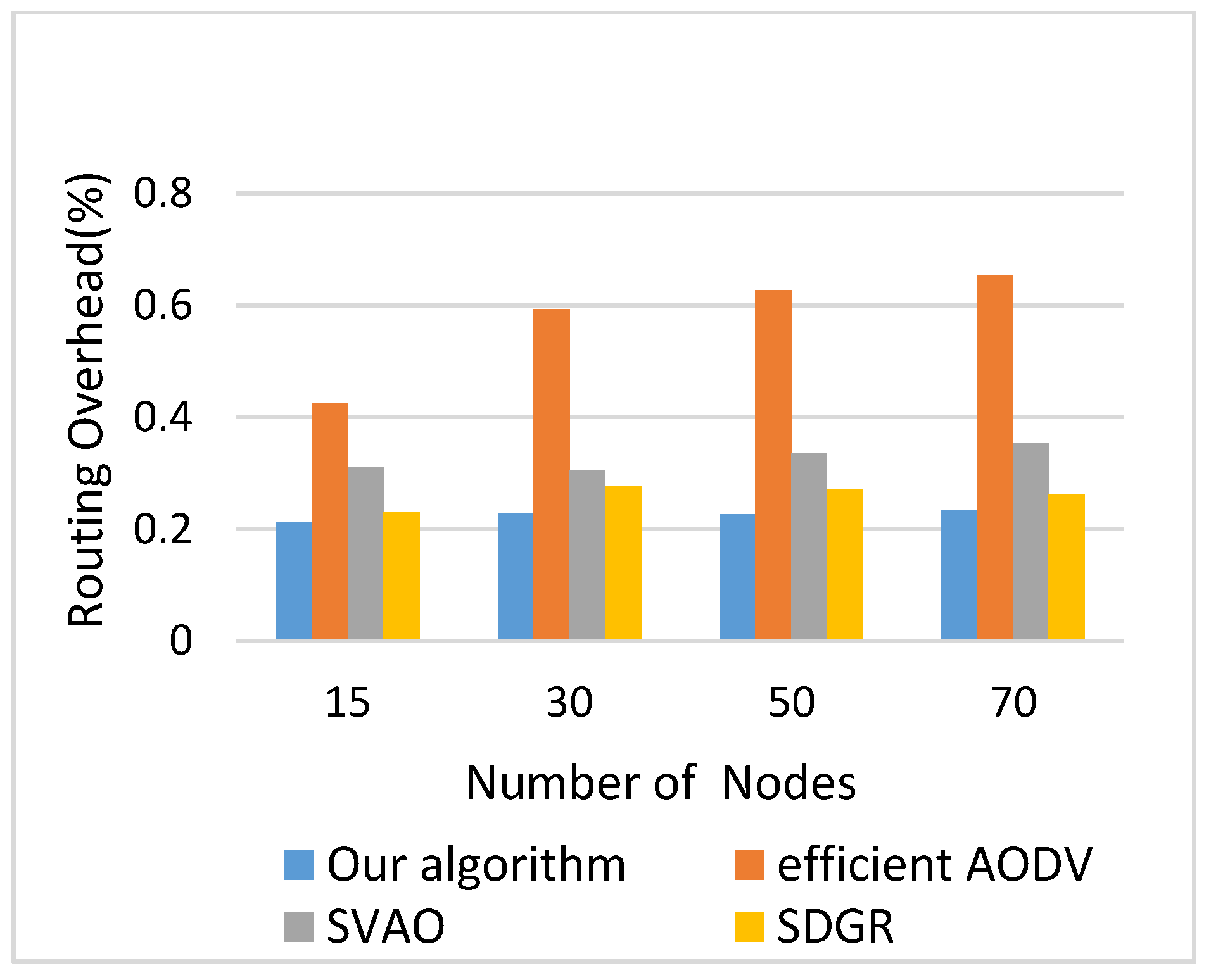
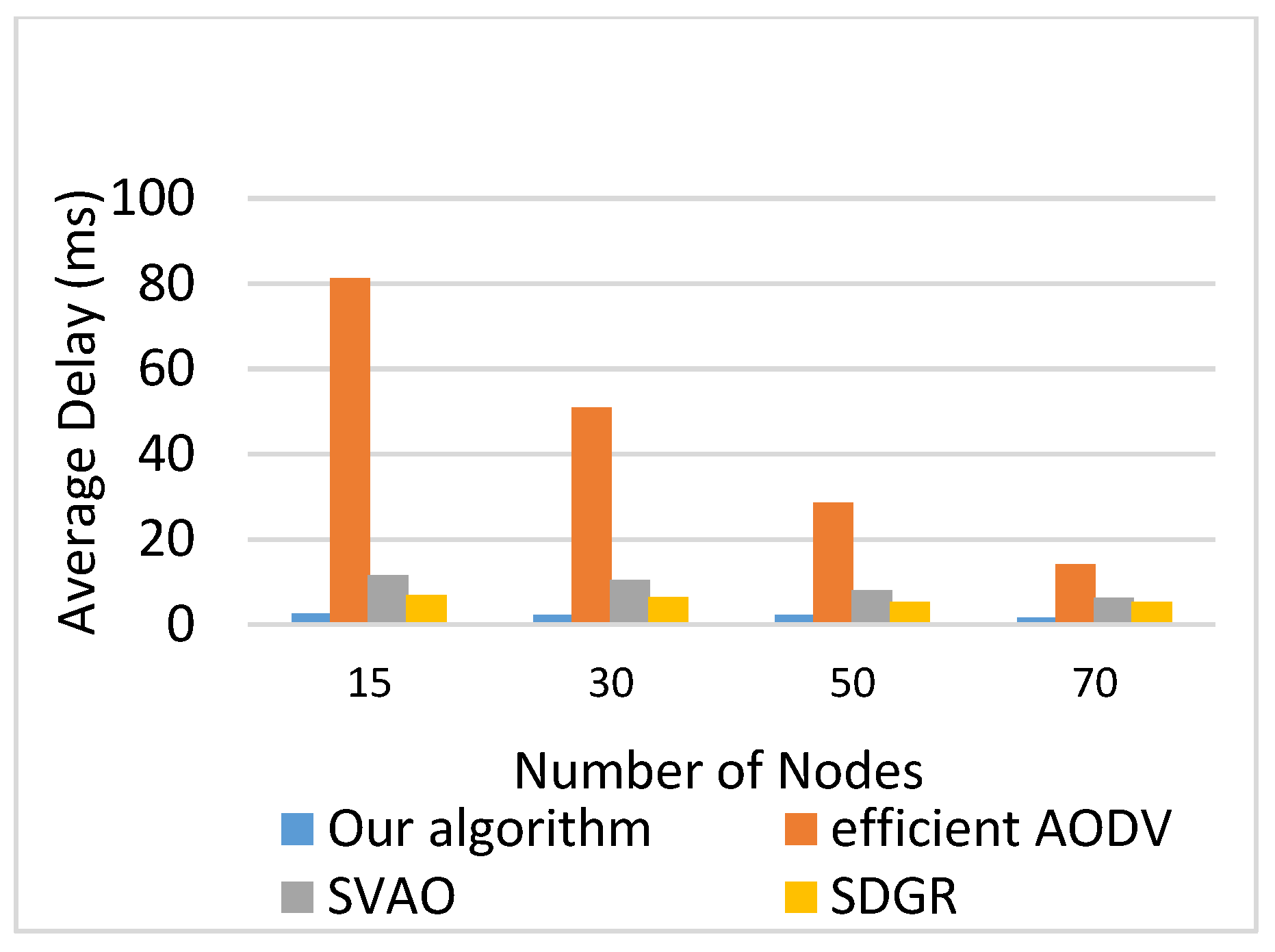
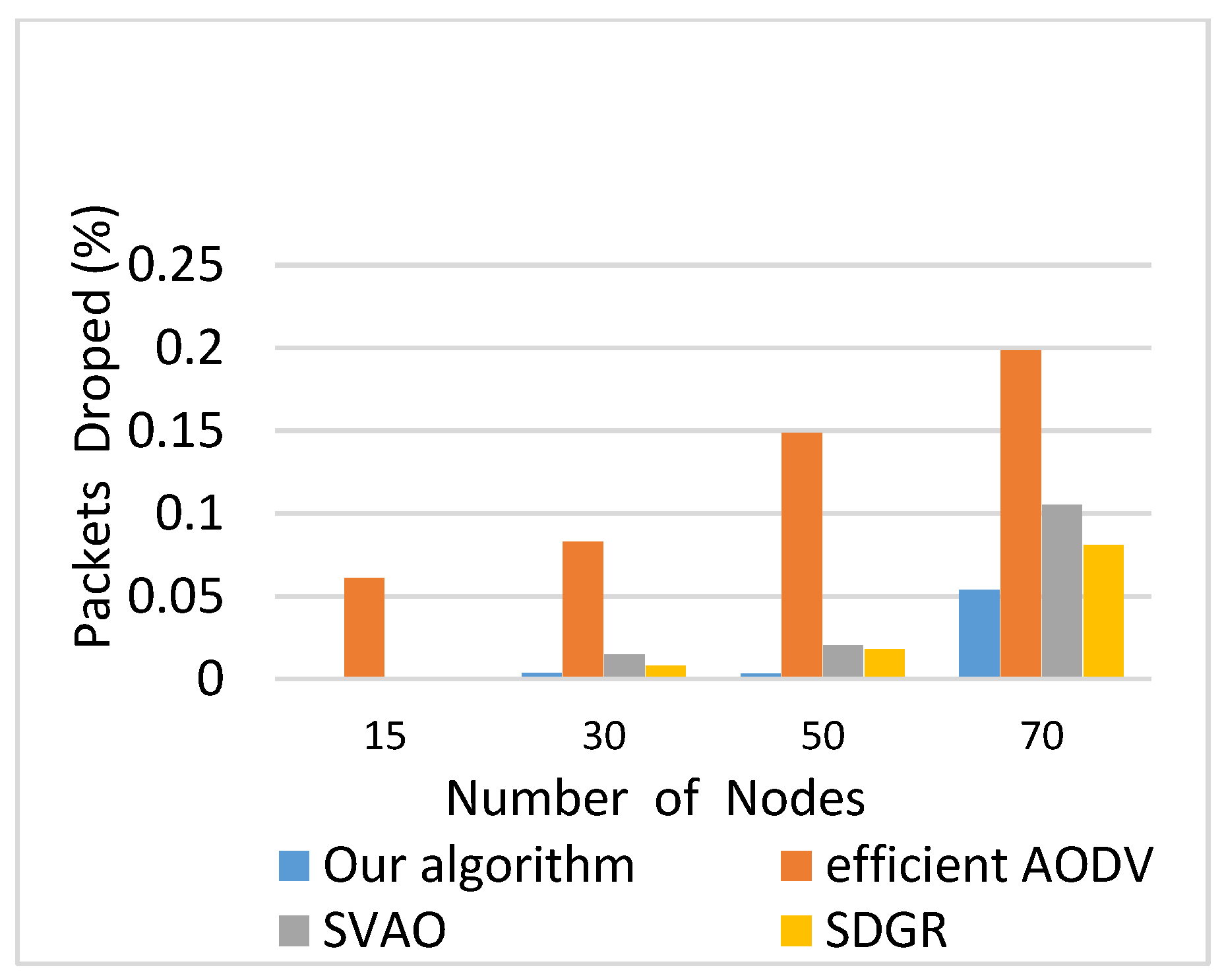
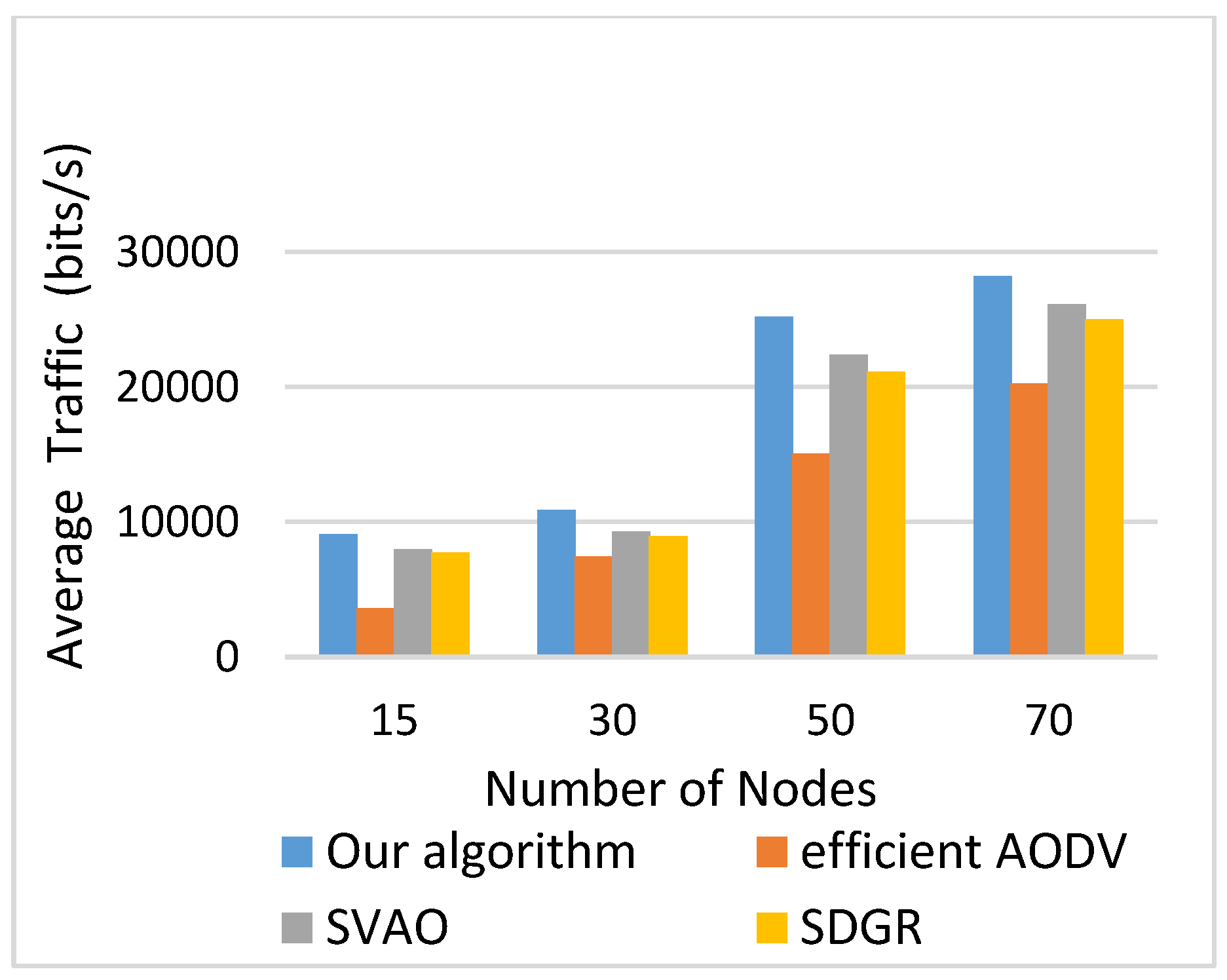
| Number of Nodes | 15, 30, 50, above 70 |
|---|---|
| Total simulation time | 300 s |
| Area size | 10 × 5 km |
| Packet size | 1024 bytes |
| MAC protocol | IEEE 802.11 p |
| Mobility Model | Random Waypoint |
| Vehicle moving speed | 15–20 km/h |
| Vehicle max speed | 25 km/h |
| Radio range | 500 m |
| Link alive time | 5 s |
| Broadcasting cycle | 1–1.5 s |
| Max distance | 2 km |
| Protocols | Efficient AODV, SVAO, SDGR, the proposed algorithm |
© 2019 by the authors. Licensee MDPI, Basel, Switzerland. This article is an open access article distributed under the terms and conditions of the Creative Commons Attribution (CC BY) license (http://creativecommons.org/licenses/by/4.0/).
Share and Cite
You, Z.; Cheng, G.; Wang, Y.; Chen, P.; Chen, S. Cross-Layer and SDN Based Routing Scheme for P2P Communication in Vehicular Ad-Hoc Networks. Appl. Sci. 2019, 9, 4734. https://doi.org/10.3390/app9224734
You Z, Cheng G, Wang Y, Chen P, Chen S. Cross-Layer and SDN Based Routing Scheme for P2P Communication in Vehicular Ad-Hoc Networks. Applied Sciences. 2019; 9(22):4734. https://doi.org/10.3390/app9224734
Chicago/Turabian StyleYou, Ziyi, Guixian Cheng, Yi Wang, Pu Chen, and Shiguo Chen. 2019. "Cross-Layer and SDN Based Routing Scheme for P2P Communication in Vehicular Ad-Hoc Networks" Applied Sciences 9, no. 22: 4734. https://doi.org/10.3390/app9224734
APA StyleYou, Z., Cheng, G., Wang, Y., Chen, P., & Chen, S. (2019). Cross-Layer and SDN Based Routing Scheme for P2P Communication in Vehicular Ad-Hoc Networks. Applied Sciences, 9(22), 4734. https://doi.org/10.3390/app9224734




